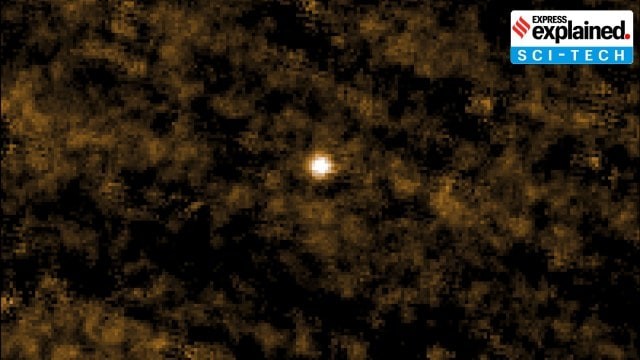





Source: INDIATODAY
Disclaimer: Copyright infringement not intended.
Context
Details
Key Details
|
Aspect |
Details |
|
Mission Name |
CubeSat Radio Interferometry Experiment (CURIE) |
|
Launch Date |
July 9, 2024 |
|
Launch Vehicle |
ESA Ariane 6 rocket |
|
Launch Site |
French Guiana |
|
Technique |
Low frequency radio interferometry |
|
Spacecraft Design |
Two miniature spacecraft, no larger than a shoebox, orbiting approximately two miles apart |
|
Frequency Range |
0.1 to 19 megahertz (frequencies blocked by Earth's upper atmosphere) |
|
Orbit Altitude |
360 miles above Earth's surface |
|
Key Instruments |
Eight-foot antennas deployed by the spacecraft to detect and measure radio waves from the Sun |
Mission Goals
Scientific and Technological Significance
Sun's Radio Waves
Types of Solar Radio Emissions
Solar Radio Emission and Solar Activity
Solar Radio Bursts
Observational Techniques
|
Type of Wave |
Description |
Examples |
|
Mechanical Waves |
Require a medium to travel through (solid, liquid, or gas). |
Sound waves, water waves, seismic waves |
|
Electromagnetic Waves |
Do not require a medium, can travel through a vacuum. |
Radio waves, microwaves, infrared, visible light, ultraviolet, X-rays, gamma rays |
|
Transverse Waves |
Particles of the medium move perpendicular to the direction of wave propagation. |
Light waves, waves on a string, surface waves on water |
|
Longitudinal Waves |
Particles of the medium move parallel to the direction of wave propagation. |
Sound waves, primary seismic waves (P-waves) |
|
Surface Waves |
Travel along the surface of a medium with particles moving in a circular motion. |
Ocean waves, ripples on water |
|
Matter Waves |
Quantum mechanical description of particles exhibiting wave-like properties. |
Electron waves, neutron waves |
|
Complex Waves |
Combination of transverse and longitudinal motions. |
Tsunamis, Rayleigh seismic waves |
|
Torsional Waves |
Wave that twists around the axis of propagation. |
Waves in bridges, skyscrapers, airplane wings |
Types of electromagnetic waves, their properties, and applications:

|
Type of Wave |
Wavelength Range |
Frequency Range |
Properties |
Applications |
|
Radio Waves |
> 1 m |
< 300 MHz |
Long wavelengths, can penetrate through air, used for communication |
Radio and TV broadcasting, wireless networking, navigation, MRI, radar systems |
|
Microwaves |
1 mm to 1 m |
300 MHz to 300 GHz |
Shorter wavelengths than radio waves, absorbed by water molecules |
Cooking (microwave ovens), satellite communication, radar, WiFi, Bluetooth |
|
Infrared (IR) |
700 nm to 1 mm |
300 GHz to 430 THz |
Experienced as heat, emitted by warm objects |
Remote controls, night-vision devices, thermal imaging, heaters, optical fiber communication |
|
Visible Light |
400 nm to 700 nm |
430 THz to 750 THz |
Detected by the human eye, various colors based on wavelength |
Vision, photography, illumination, lasers, fiber optics |
|
Ultraviolet (UV) |
10 nm to 400 nm |
750 THz to 30 PHz |
Can cause skin tanning and burns, higher energy than visible light |
Sterilization, fluorescent lights, UV tanning beds, detecting forgeries |
|
X-Rays |
0.01 nm to 10 nm |
30 PHz to 30 EHz |
Penetrate most materials, high energy |
Medical imaging (X-rays), security scanners, cancer treatment |
|
Gamma Rays |
< 0.01 nm |
> 30 EHz |
Highest energy, can penetrate through most materials |
Cancer treatment (radiotherapy), sterilizing medical equipment, astronomical observations |
A short note on Sun

|
Category |
Details |
|
Basic Information |
|
|
Names |
The Sun is referred to as "Sol" in Latin and "Helios" in Greek mythology. |
|
Age |
Approximately 4.6 billion years old. |
|
Distance from Earth |
About 93 million miles (150 million kilometers). |
|
Physical Characteristics |
|
|
Type |
G-type main-sequence star (G2V). |
|
Diameter |
About 865,000 miles (1.4 million kilometers). |
|
Mass |
Approximately 330,000 times the mass of Earth. |
|
Composition |
Mainly hydrogen (about 74%) and helium (about 24%), with trace amounts of heavier elements. |
|
Structure |
|
|
Core |
The hottest part of the Sun, with temperatures reaching around 27 million °F (15 million °C). Nuclear fusion occurs here. |
|
Radiative Zone |
Surrounds the core, where energy is transferred outward by radiation. |
|
Convection Zone |
Above the radiative zone, where energy is transferred by convection. |
|
Photosphere |
The visible surface of the Sun, with temperatures around 10,000 °F (5,500 °C). |
|
Chromosphere |
Above the photosphere, visible during solar eclipses. |
|
Corona |
The outermost part of the Sun's atmosphere, extending millions of miles into space and with temperatures reaching up to 3.5 million °F (2 million °C). |
|
Orbit and Rotation |
|
|
Orbit |
The Sun orbits the center of the Milky Way galaxy, taking about 230 million years for one complete orbit. |
|
Rotation |
The Sun rotates on its axis with a period of about 25 days at the equator and 36 days at the poles. |
|
Magnetic Activity |
|
|
Sunspots |
Darker, cooler areas on the surface, associated with magnetic activity. The number of sunspots varies in an approximately 11-year cycle. |
|
Solar Flares |
Sudden, intense bursts of radiation caused by the release of magnetic energy. |
|
Coronal Mass Ejections |
Large expulsions of plasma and magnetic field from the Sun's corona that can impact Earth's magnetosphere. |
|
Solar Wind |
A stream of charged particles (mostly electrons and protons) emitted from the Sun's outer layers, traveling at about 450 km/sec. |
|
Future Evolution |
|
|
Red Giant Phase |
In about 5 billion years, the Sun will expand into a red giant, engulfing the inner planets, including potentially Earth. |
|
White Dwarf |
Eventually, the Sun will shed its outer layers, leaving behind a dense, hot core that will cool over billions of years. |
|
Impact on Earth |
|
|
Light and Heat |
Essential for life on Earth, driving weather patterns and photosynthesis. |
|
Space Weather |
Solar activity affects satellite operations, power grids, and communication systems. |
|
Auroras |
Interaction between solar wind and Earth's magnetic field causes auroras (Northern and Southern Lights). |
Must read articles:
Sources:
|
PRACTICE QUESTION Q: Consider the following statements regarding the Sun:
Which of the statements given above is/are correct? a) 1 and 2 only Answer: d) |






© 2025 iasgyan. All right reserved